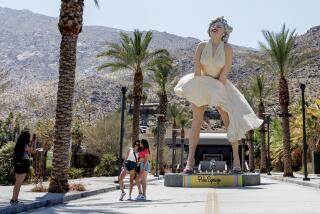City Offers a Seat to a Statesman : Sculpture: A statue honoring Benjamin Franklin in the city’s redevelopment area may signal the future of public art in Glendale.
- Share via
It is not an unusual sight in Glendale: a bespectacled, jovial-looking fellow shares a park bench with a couple of pigeons.
But this fellow is Benjamin Franklin, cast in bronze. Clutched in his hand is the U.S. Constitution, which he helped write. The pigeons, too, are frozen in a permanent pose.
The scene in a brick-paved plaza at 135 N. Brand Blvd. was unveiled last weekend as the city’s first publicly owned art in the downtown redevelopment zone. It is a salute to a statesman who died 200 years ago, but also signals the future of public art in Glendale.
Public art in Glendale has become important, city officials say. No matter what the art form--whether historical or modern sculptures, architectural design or even cultural events--a city policy adopted in September mandates that it be incorporated into new developments in the downtown area.
The Glendale City Council last year began setting aside $100,000 a year in public funds to establish a city arts program. The money could be used to purchase new art or to restore historical pieces, such as the 1928 statue of Miss American Green Cross--a salute to early conservation efforts--that was wrecked by vandals and has been stored for years.
The 600-pound, life-size Ben Franklin, however, was donated to the city by the Howard-Platz Group of Glendale, developer of The Exchange, where the statue is reposed near a gurgling three-tier fountain in a courtyard.
Expected to be completed by summer, The Exchange is a two-block center of upscale shops, restaurants and offices in an area bounded by Brand Boulevard, Broadway, Wilson and Louise streets. Featured will be an eight-screen theater under construction on Maryland Avenue between Wilson and Broadway.
The Howard-Platz Group purchased the Franklin statue for $33,000 and dedicated it to the city Saturday. One of an edition of 21, the statue was created in 1987 by sculptor George Lundeen of Colorado.
Richard L. Daughterty, project manager for the Howard-Platz Group, said developers sought an art form that “would be historical, recognizable and understood by all generations of people.” He said the Franklin bronze was selected after a series of informal discussions with city officials.
Born in 1706, Franklin, son of a Boston soap maker, had little schooling. Yet he learned French, Italian, Spanish and Latin; invented the Franklin stove, bifocal glasses and the lightning rod; and was one of the most skilled diplomats in the nation’s history. He also is credited with helping to establish public libraries, the post office, fire and police departments, hospitals and services such as street paving and lighting. Franklin died in 1790.
More to Read
Sign up for Essential California
The most important California stories and recommendations in your inbox every morning.
You may occasionally receive promotional content from the Los Angeles Times.













